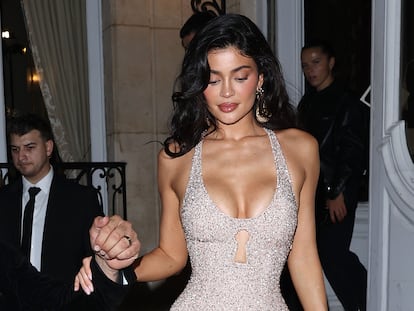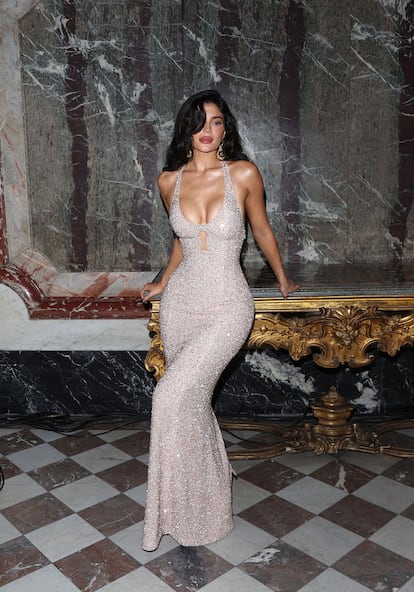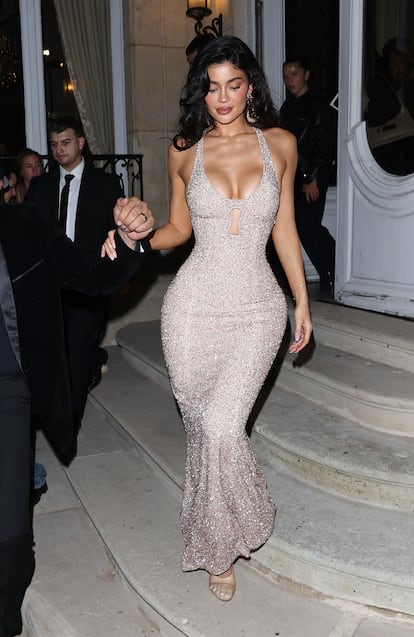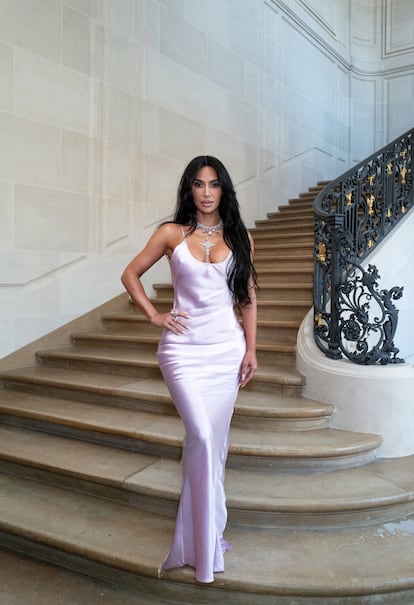The drag queen tricks that build the unrealistic body shape that the Kardashians flaunted in Paris
Kylie Jenner has brought the figure that defines the Kardashian-Jenner clan back into the spotlight. Far from being the result of genetics and working out, this physique is the result of corsetry and fillers; ignoring that fact creates dangerous and unattainable beauty standards

For as much as the Kardashians have been celebrated for having changed beauty standards with their curves, the reality is that they have rarely taken responsibility for showing off such unrealistic figures. One example came in the ninth episode of the third season of their reality show, when Kylie Jenner — who tried to make the world believe that her voluminous lips were the result of her brand’s lipsticks, only to later admit to resorting to injections — commented to Kourtney Kardashian that, given the influence they have, perhaps they should assume responsibility for their impact on beauty standards. “I see a lot of young girls on social media and on the internet who are totally filtered. I went through that stage too, but I’m better now. This can cause insecurities in other people,” the cosmetics entrepreneur explained to her sister.

However, at the Schiaparelli fashion show at Paris Fashion Week, she once again left the world stunned by transgressing aesthetic limits by wearing the brand’s haute couture dress, in which she flaunted a silhouette worthy of Jessica Rabbit, following the family’s recent trend: they still have a lot of curves but are much thinner than in the past. The figure is so unrealistic that it is reminiscent of a cartoon. Elena Rue Morgue reflected on that in a tweet. “Kylie’s body (like the rest of the family) is impossible without surgery and a lot of money, but here in particular she wears a tremendous hourglass corset and padding (padding, like a drag queen) on her hips: when she’s walking, you notice how she moves,” the journalist noted on her social media. Rue Morgue uploaded a video in which she demonstrates how one’s figure can be altered to simulate that “hourglass” silhouette in just a few minutes by wearing a corset.
“I know how corsets work perfectly well because I was a goth in high school. I love the Victorian era and I love that silhouette, so I’ve been corseted all my life,” she explains to S Moda. “When I saw the images, it’s true that I thought Kylie had slimmed down a lot, but the truth is that that body didn’t seem right to me… When I saw [Jenner’s body] in motion, I understood what we were dealing with. When I saw her sitting down, I noticed that she was wearing padding, a silhouette from the 1940s created by Dior. But I wondered how people could know it when they saw it. Considering that our minds are totally distorted about the reality of bodies because of social media, where, as Kylie clearly showed, they all narrow their waists as if they were Disney princesses. I thought it was important to explain that these images have a lot of work put into them. In real life, no one has that body without a corset, because they are not realistic proportions,” the journalist notes. She adds that she made her video to try to break the distortion that the images of the youngest Kardashian can cause.

A project under construction
Upon seeing the photos of Jenner’s Jessica Rabbit silhouette, José Luis Díaz Megías, the creative director of the fashion company It-Spain, opines that the look must have significant corsetry underneath. “We must also highlight the materials and the cuts of the design, as they help to achieve that silhouette, since we are talking about a couture dress. Perhaps Kylie is wearing some padding, but I’m not sure if it’s padding. In this case, we are not talking about a slimming corset, because it would bring out more tummy, but rather one made to fit her,” he explains.
Virtudes Ruíz and María Vicente, cosmetic surgeons and doctors with practices in Murcia and Lorca, Spain, believe that beyond fashionista matters, the Kardashian and Jenner women’s figure, featuring generous rounded buttocks without cellulite or dimples, may require going under the knife and using specific prostheses for the buttocks. “We’re talking about an aid, especially hyaluronic acid, to finish rounding and give a nice shape to this area, since with prostheses we get projection and elevation, but if they do not have a rounded shape they do not look pretty. That is why we use hyaluronic acid to finish the rounding, as well as polylactic acid, which we use to give firmness to the skin in this area and improve cellulite dimples, if there are any,” they say.
All the experts consulted for this article agree on the importance of making it clear that this image is not the result of genes or chance. According to fashion designer Maya Hansen, a lot of work and artifice goes into it. “A corset maker can work wonders, and we have to take into account that behind the images there is a team that works to make that image come to light, because it is pure marketing. I believe that with good padding and structures, anyone who wears a size 38, for example, can achieve something similar, but we must clarify that there is a lot of inner work in this type of garment. The result of what we see for a few moments is really the work of months of work on your body, with several sessions to try on and [ensure] that everything fits like a glove. In haute couture, we are talking about a task that can take months,” says the designer, who dressed Jenner for her 18th birthday celebration.
José Luis Díaz Megías also believes that the work behind the image is intense. “You have to put in corsetry training. If you wear a corset every day, your body, after three months, will take on that shape. Of course, that doesn’t mean that you take it off and you get that shape, but it is noticeable. What you have to know is that under a dress like that, there is usually a base corset or a bustier corset. In short, those who make a living with their bodies, like the Kardashians and the Jenners, can achieve that silhouette with training, with corsetry, with surgery... In the end, their figure is their work tool; if they go to these extremes, it is because they make a profit [from it],” he says. Díaz Megías differentiates this look from the one Kim Kardashian wore at the Met gala, where she emulated Marilyn Monroe and sparked a controversy. “Kim’s dress was a design with soft transparent fabric, so in that case, it would have been impossible to put corsetry, because it would have shown. She might have been wearing a slimming catsuit that tightens and molds. If corsetry had been used, it would have given it a bit of orthopedics. When the Kardashians choose to wear girdles on top of girdles, they have to put a stocking on top, as drag queens do, so that the cuts don’t show,” he explains.

A custom-made corset
Both designers believe that Jenner doesn’t wear just any corset but one created exclusively for her. We asked Hansen how this type of custom design is created for a well-known client’s silhouette. “We ask for some faceless photographs and measurements taken by a professional. In fact, sometimes we even ask for two different types of dressmakers to take the measurements so we can get a more or less realistic average of their measurements, because there are often differences of opinion about how the [measurements] are taken. With the profile pictures [from the] front [and] back and sometimes…a 360º video, as well as the height, which affects sizes (along with the height of the chest, it is a basic measure for a corset maker), you can start to mold and work. It is essential to ask what effect you want to achieve and if you want any particular reductions. For example, if you want tightlacing, which was used in the seventeenth and eighteenth centuries (Mister Pearl was the master), we are talking about extreme corsetry, and we get into extreme pattern reduction there. That is why it is essential to know how many sizes you want to reduce and how many centimeters of waist you want. We have flexible Russian mannequins for trying on the corset and it’s as if you were putting it on a real person,” she explains. “In the end, it’s a work of architecture for the body. We are designers who are a lot like architects,” he says.
The problem with the silhouette promoted by the Kardashians and its influence on women’s body images is in the way they have suggested that their appearance is the result of working out and surgery, as Jessi Kneeland, the author of Body Neutral: A Revolutionary Guide, warns. In so doing, they remove their resources and privilege from the equation. “It’s important to stop overvaluing and always focus on what’s valid in the body and/or aesthetic. It’s not about whether a curvy body or a slimmer body is better or more real, because they are all real and valid, but [the point is] to stop giving it so much attention and importance. Even if it is intended to give a positive message, sometimes it creates more noise or even new phobias and types of rejection. That dissatisfaction of not [looking like] those role models promotes the pursuit of all kinds of resources to modify the body, sometimes [prioritizing them] over health. We should not confuse wanting to look good, enjoy our body and aesthetics, with meeting standards that are impossible to achieve, no matter how much you exercise or change your diet,” says Blanca Torrado, a psychologist at the Psychonutrition Space in Spain.
Sign up for our weekly newsletter to get more English-language news coverage from EL PAÍS USA Edition
Tu suscripción se está usando en otro dispositivo
¿Quieres añadir otro usuario a tu suscripción?
Si continúas leyendo en este dispositivo, no se podrá leer en el otro.
FlechaTu suscripción se está usando en otro dispositivo y solo puedes acceder a EL PAÍS desde un dispositivo a la vez.
Si quieres compartir tu cuenta, cambia tu suscripción a la modalidad Premium, así podrás añadir otro usuario. Cada uno accederá con su propia cuenta de email, lo que os permitirá personalizar vuestra experiencia en EL PAÍS.
¿Tienes una suscripción de empresa? Accede aquí para contratar más cuentas.
En el caso de no saber quién está usando tu cuenta, te recomendamos cambiar tu contraseña aquí.
Si decides continuar compartiendo tu cuenta, este mensaje se mostrará en tu dispositivo y en el de la otra persona que está usando tu cuenta de forma indefinida, afectando a tu experiencia de lectura. Puedes consultar aquí los términos y condiciones de la suscripción digital.
More information
Archived In
Últimas noticias
NASA discovers Titan doesn’t have an ocean, but a ‘slushy ice layer’ that increases possibility of life
Innocence lost in the forest of the child soldiers: ‘Each leader of the armed group had his girls’
‘Fallout’ or how the world’s largest company turned an anti-capitalist apocalyptic Western into a phenomenon
From inflation to defending migrants: Eileen Higgins and Zohran Mamdani inaugurate the new Democratic resistance against Trump
Most viewed
- ‘El Limones’ and the growing union disguise of Mexican organized crime
- Christian Louboutin: ‘Young people don’t want to be like their parents. And if their parents wear sneakers, they’re going to look for something else’
- The low-cost creative revolution: How technology is making art accessible to everyone
- ‘We are dying’: Cuba sinks into a health crisis amid medicine shortages and misdiagnosis
- Liset Menéndez de la Prida, neuroscientist: ‘It’s not normal to constantly seek pleasure; it’s important to be bored, to be calm’











































